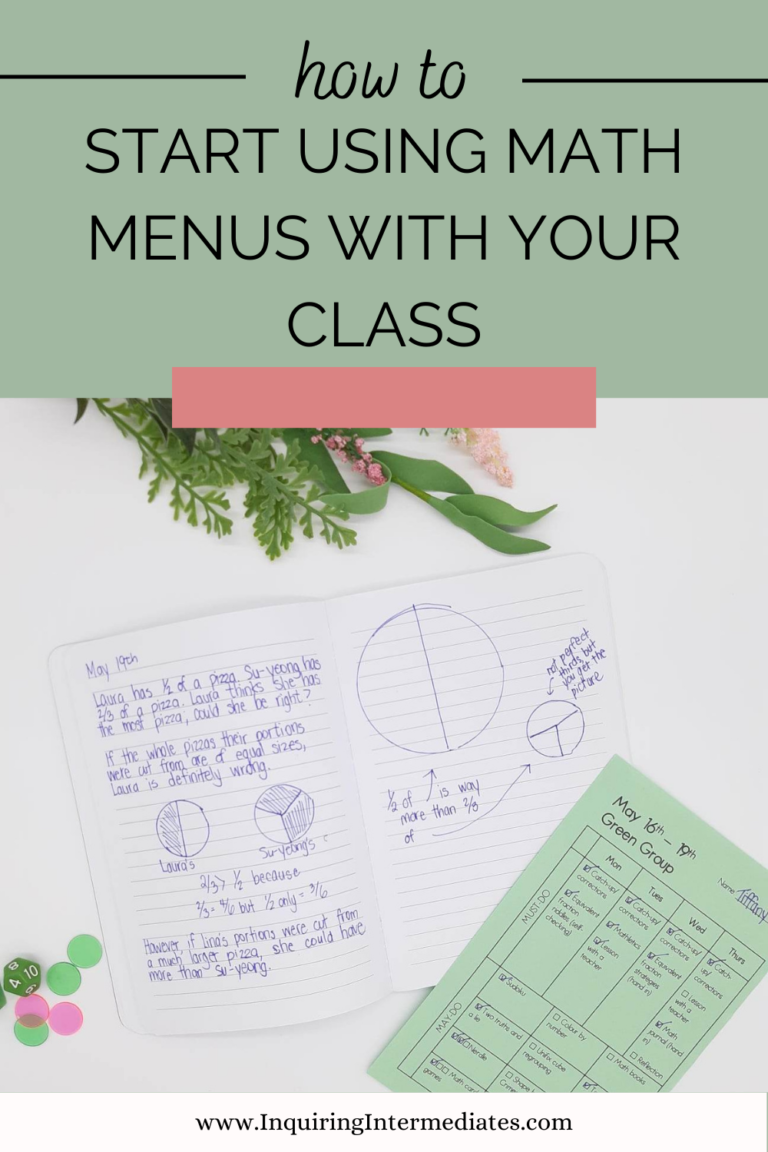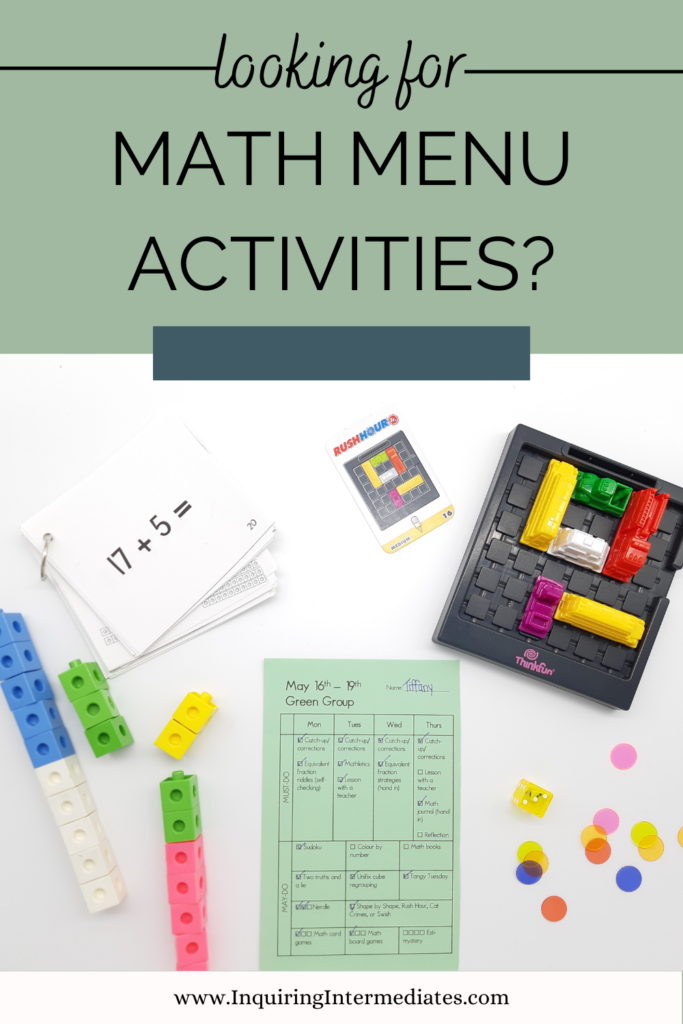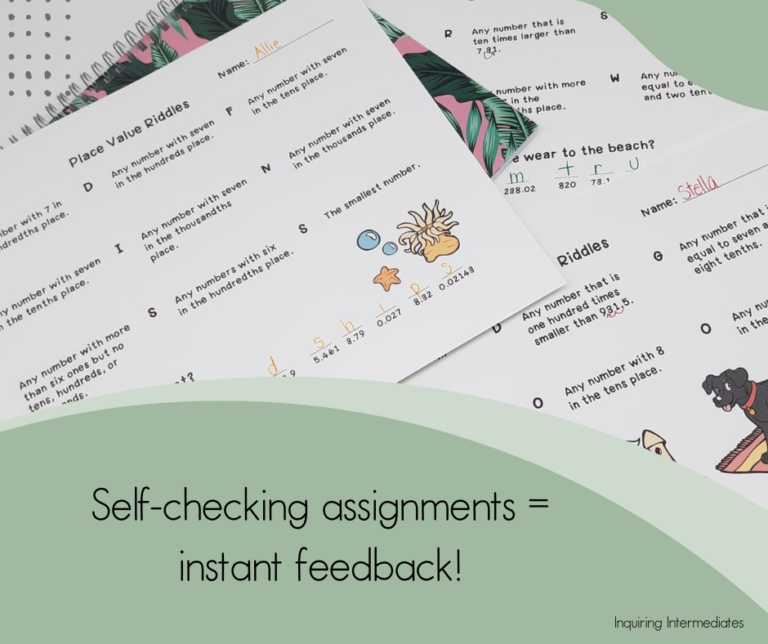Last Spring, inspired by Juliana Matherson‘s pro-d session on math menus, a couple of coworkers and I decided to take the plunge and start using menus for math. It was great to be able to share resources and ideas with one another! If you’re thinking of giving math menus a try, I’m here to share resources and ideas with you.
In my class, we do math menus Monday through Thursday. On Fridays, we play math games or engage with one of Peter Liljdahl’s Good Problems.
What are math menus? How do you structure math menus and how long do they take?
A math menu is just a choice board for math that also includes assignments students must do. I have the must-do assignments listed at the top of the page and broken up by date. The may-do math choice board ideas as listed on the bottom.
By Wintertime, my math menu blocks are 45-minutes to an hour
long. In the beginning of the year, I usually make them shorter as kids build
their stamina. The block consists of three main activities:
· paired or small group work with the teacher (2-3 sessions/week for each group)
· independent must-do activities (everyday)
· may-do choices that can be done independently or with friends (everyday)
This structure gives me time to meet regularly with each student in a small group, provides challenges and time to practice fundamental skills, and gives kids an opportunity to choose activities that they enjoy.
What are must-do tasks for math menus?
Each day, students have one must-do activity that they need to finish. I try to change them up, but every week they have:
· lessons with a teacher
· a math journal prompt
· a Mathletics activity (this is a subscription-basedwebsite my district pays for)
· a worksheet or two
· a reflection – at the end of the week, I also ask kids to write a sentence or two on the back of their menu about what they learned and how they did. They can comment on their behaviour, choices, or what they actually learned. They take these home every week so their families can see what they’ve been doing.
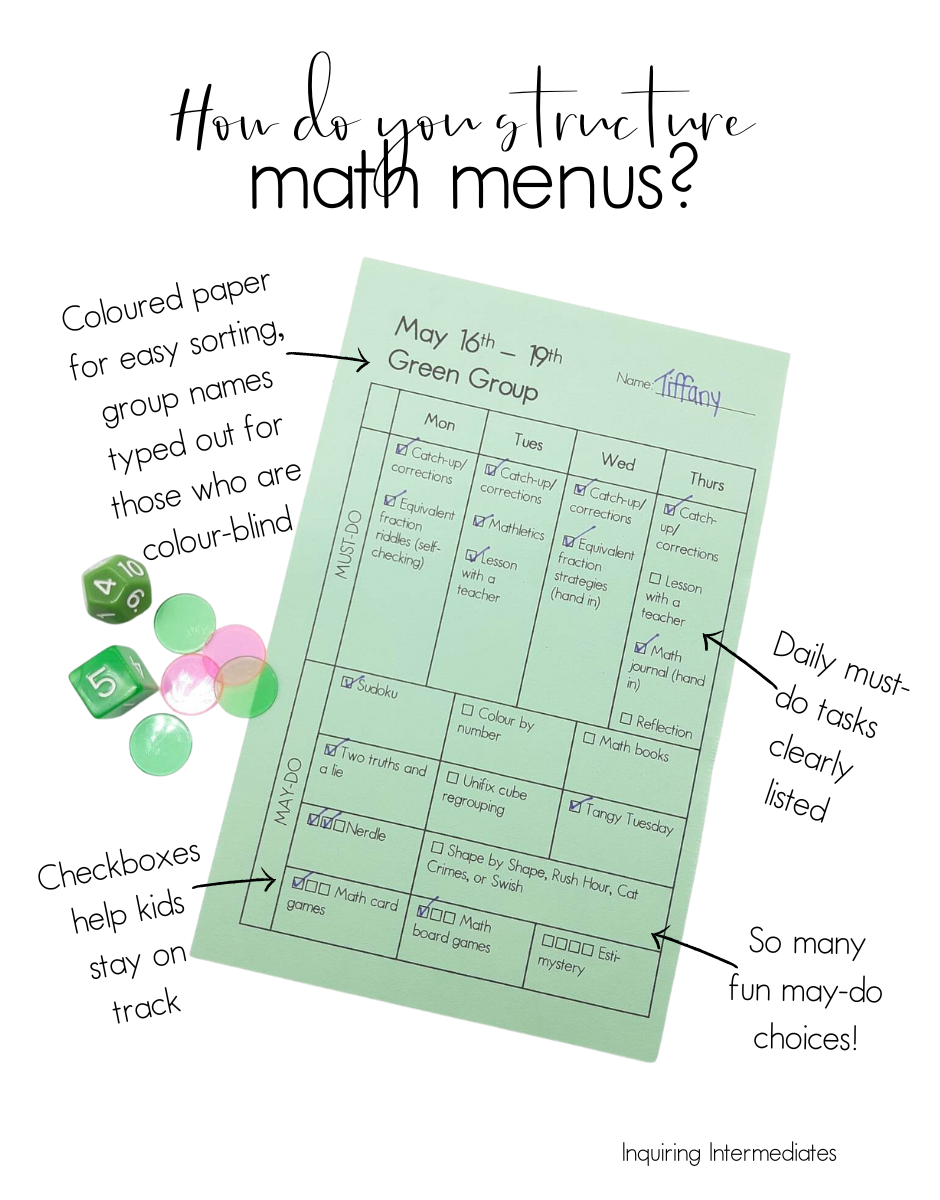
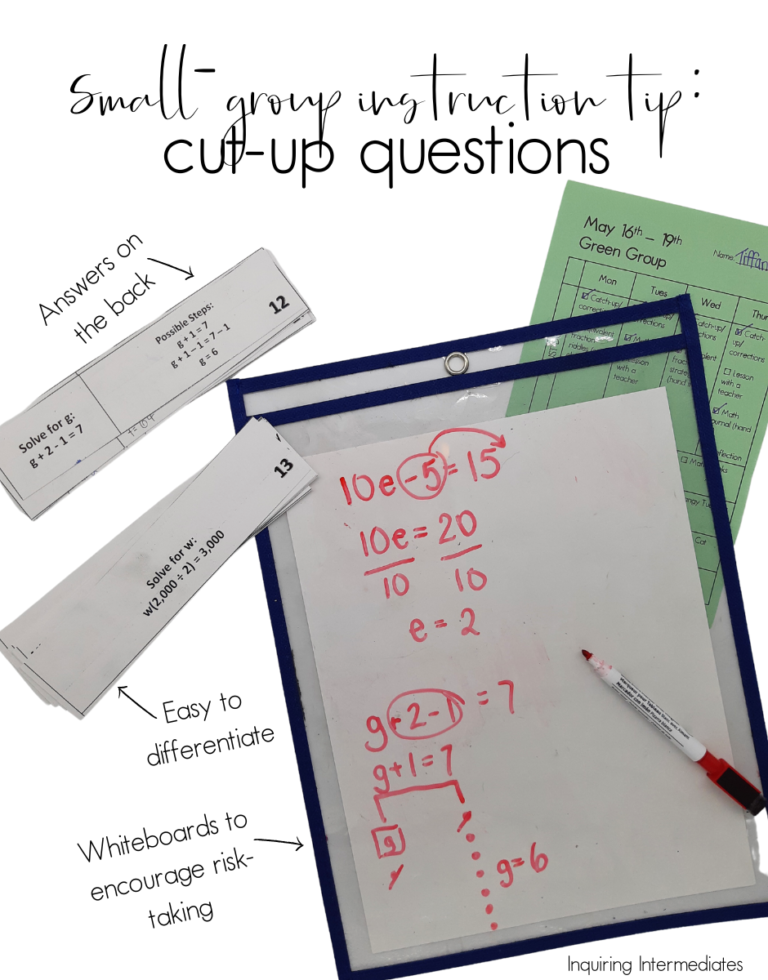
Must-do: Lesson with a teacher
Each group meets with me twice a week. Our resource teacher also works with one of the groups, so they get three sessions a week. Whenever I introduce a new concept, I make sure that no group is assigned work that requires that concept until after it has been taught at the carpet. I’ll usually introduce something new by giving a problem and challenging kids to solve it. Once they’ve come up with a few strategies, successful or unsuccessful, we go over them together. Successful strategies get recorded in a notebook where we outline definitions and do some examples. During the next session, groups begin working on cut-up questions.
What are cut-up questions?
This is an idea I got from Juliana Matherson, although she calls them thin-sliced questions. Essentially, these are math questions that are cut individually. They increase in difficulty as they go along so students can build confidence without getting overwhelmed by the questions to come. Each student gets their own set and works at their own pace.
Usually, completing the first six to ten questions shows competence with the fifth-grade curriculum; anything after that is an extension. I’ve found that students seem more eager to work on challenging cut-up questions than they would be to do ‘bonus questions’ on a worksheet. Cutting the questions makes differentiation easy. One student might finish only five. Another might start at question ten.
Each question has an answer on the back because, for the most part, these aren’t open-ended questions. Students check the answers and ask themselves if they ‘get it’ or if they need help. This requires some accountability, but I can also look at the work on their whiteboards or have them walk me through a question. Because there are only five or six students in each group, I can keep an eye on everyone. Kids place their finished questions answer-side-up on the carpet so they can flip the complete set over when they’re done and leave them ready for the next group.
Must-do: Math journals
Math journal prompts are usually questions that could be answered in more than one way. Sometimes, I use trick questions with an ‘____ unless…” answer. The goal is to give kids an opportunity to clearly explain their mathematical thinking. I just stick the math journal prompt on our weekly math menu slide, which I’ll talk about below.
Other math menu must-dos
· Math riddles – I love these because they’re self-checking, which means students get feedback right away! If they get an answer to the riddle that makes sense, it goes straight into their binders. If the answer doesn’t make sense, they show it to an adult who can help them.
· Regular math worksheets, usually not more than one sheet of paper per week.
· An extra math journal prompt
· A challenge problem to work on with other members of your math group. Sometimes I have kids record their thinking in their journals, sometimes I have them see me when they’ve solved it.
· Mathletics assignments – Mathletics is an online math program that my district pays for.
· Correct the Teacher – This idea, along with the next one, is from Juliana Matherson. Essentially, I answer a question incorrectly and the kids need to explain what I should do next time.
· That Doesn’t Make Sense – These worksheets feature one multiple-choice question. Students need to explain why each answer does or does not make sense.
What are may-do tasks for math menus?
My students would say that the may-do section, which is just a choice board for math, is the best part of math menus. Students have several may-do activities to choose from each week. They don’t have to do them all (and probably couldn’t). Each activity has a limit for how many times they can do it, and there are little checkboxes next to the name of each activity so students (and I) can keep track of how many times they’ve done something each week. The limits might be different for each group, but they generally are based on rigour (the less rigorous ones aren’t allowed as often), or supply and demand. Not all the activities are strictly math activities, some are about logic and spatial reasoning, which help them build skills they’ll need for math.
When we start using menus for math each year, we begin with only a few may-do options that we’ve already explored as a class (like math puzzles and board games). I introduce more as we go along.
Options they can choose once a week:
· Sudoku – I just cut pages out of a book from the dollar store
· Colour by Sum/Product/Fraction/Decimal, etc. – This website has so many free options to choose from!
· Two Truths and a Lie – A little number game I throw in the bottom corner of my weekly math menu slide. They can check their work by looking under a cardstock flap on the board.
· Pop-It Practice – A skip-counting/multiplication tables activity where students use these hundreds chart pop-its and pop multiples or divisors based on promtps from task cards.
· Think Fun games – My most popular may-do options. We have Rush Hour, Shape by Shape, Swish, and Cat Crimes. Cat Crimes is technically a one-player game, but I let students work in groups of up to three.
· Math picture books
· Mathletics games
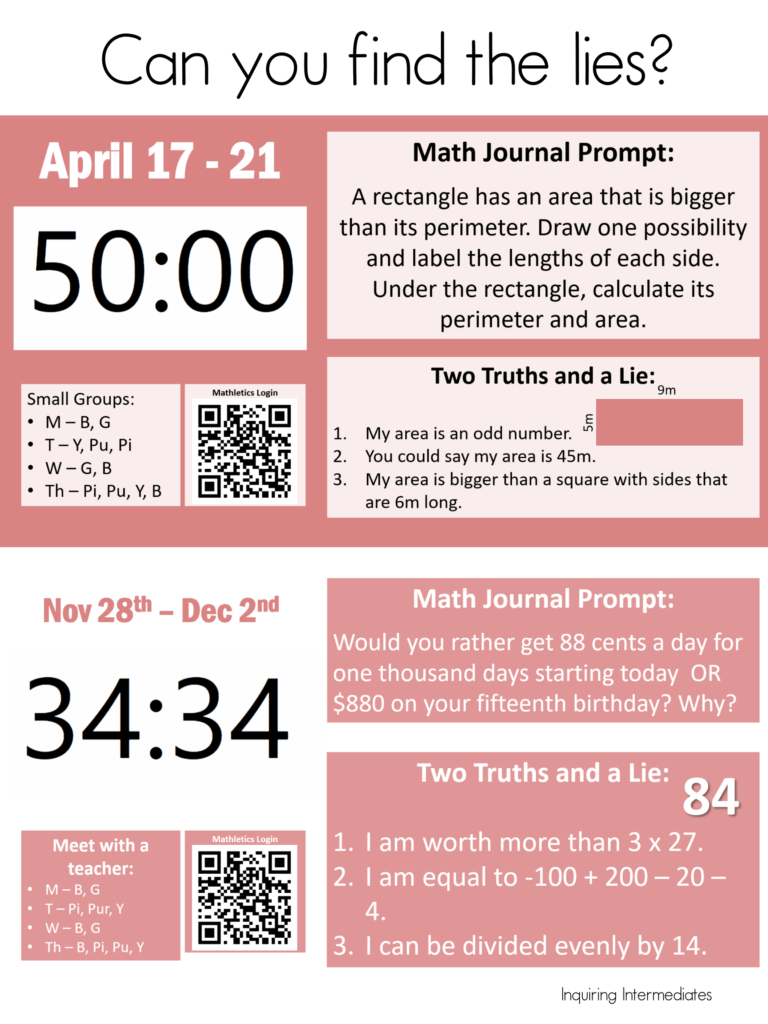
Options they can choose two or more times each week:
· Math Board Games – There are lots of free and cheap ones available on TPT.
· Math Card Games – I printed out a set of card game instructions and put them on binder rings. They’re stored with our cards. Each box and deck of cards has been labelled with a letter so we know what to do with stray cards that inevitably get found on the ground.
· Esti-mysteries – Steve Wyborney offers hundreds of what he calls esti-mysteries for free on his website, and my class loves them. Each one features a picture of several small objects in a clear container alongside hints that would help kids make an informed estimate. Wyborney uses Powerpoints that reveal the hints one by one. I downloaded several of his slideshows, copied the last slides into one master Powerpoint document, and printed them out on cardstock. I keep them in a magnetic pouch on the board and use a folded piece of dark cardstock to cover the clues. Each day, a student folds the paper once more to reveal a new clue. Students’ cross numbers off on a hundreds chart to narrow down their estimates. At the end of the week, they drop their slips into a box. On Friday or Monday morning, I draw slips and check the estimates. The first person to get the right answer (or close, if there were lots of reasonable estimates) can choose between a small prize (ex. pencils, bookmarks, erasers, water bottle stickers) or money for our classroom economy (which doesn’t buy them anything physical, but they like ‘having it’). I let kids revisit this station every day as new clues are revealed.
· Unifix Cube Regrouping – Kids use the cubes to demonstrate subtraction and addition with regrouping. They get the equations from a set of task cards. This activity is a great way for them to see how regrouping works! It can also be a good must-do or small group activity for kids that need extra practice.
· Base Ten Block Building – Kids use base ten blocks to build structures that match the values on a set of task cards.
· Nerdle – The math equivalent of Wordle.
Adapted math menus
Menus for math can easily be made with visuals for students who need them. When I made a visual math menu, I just used a whole page instead of a half-page. Students who aren’t able to do the same math tasks as the rest of your class can still engage with a lot of the same may-do options, albeit with adaptations or extra support. You can even add some life-skills math options, like money activities.
How to keep students on-task during math menus
Whenever possible, I schedule math menu blocks when I have support from an EA or resource teacher; more adults definitely help keep kids on-track! Of course, that support isn’t always available. Regardless, I make a point of facing the class when I work with my small groups. Some days, I don’t need to leave the group at all. Other days, I do need to check in on a few kids while my small group is working on their questions. I won’t lie and say that all my students are 100% engaged 100% of the time, but the same was true when I assigned worksheets to the whole class. I can truthfully way that my kids are much more engaged now that we use menus for math than they were when I did whole-class worksheets.
In addition to extra manpower and keeping an eye on the class, I’ve found that math menu slides help kids stay on-task as well. Our slides are home to the weekly math journal prompts and Two Truths and a Lie Question, but they also have a small group schedule and a timer. The schedule and timer help kids make informed choices and remind them to manage their time wisely.
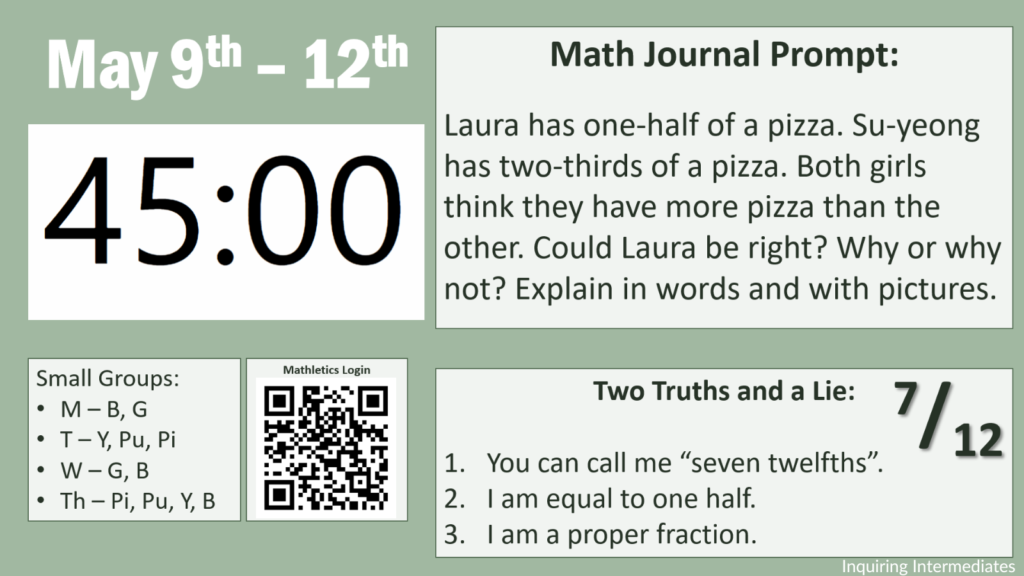
How do you assess math menu work?
Over the last few years, I’ve really tried to cut down on marking and get kids feedback more quickly. Math menus have allowed me to accomplish that goal pretty easily. I mark 6-12 math journals from Monday to Thursday and a class-worth of worksheets on Thursday or Friday. Any other worksheets that kids do are either marked by the kids (I’ll post an answer key on the door) or are self-checking. My most meaningful assessment data comes from:
Observations I make while working with small groups
I love watching the strategies kids use and seeing how they approach problems. Since the cut-up questions get progressively more difficult, I can also quickly check my notes and see which skills they are able to master by looking at how many questions they finished.
Math journals
These prompts are deeper and more open-ended than the cut-up questions, and kids are often asked to explain their thinking. If I ask them to elaborate something or make a correction, they are expected to revisit the prompt.
Correct the teacher
These sheets really force kids to think about and explain why they are doing what they are doing with words and examples. I’ll take their instructions and follow them exactly at the bottom of the page, which usually leads to an incorrect answer due to lack of clarity. Kids are expected to reclarify and resubmit the assignment as many times as possible. At the beginning of the year, they were often resubmitting these several times. Now, it’s usually just once or twice. If they miss my mistake or make a mistake of their own, a stick person will give them a little hint in the margins.
How do you store materials for math menus?
Honestly, I thought this was going to be a nightmare and it was one of the biggest concerns I had. With a little prep work, it turned out to be a breeze!
· Base ten blocks, unifix cubes, pop-its, number blocks, cards, rulers, and measuring tapes go in a set of plastic drawers. The calculators and the containers or counters and dice sit on top in baskets.
· Colour-by-numbers, hundreds charts for esti-mysteries, and sudoku pages go in a three-tiered tray.
· Math picture books are kept together in a basket by the tray.
· Math board games are colour-coded by skill and kept in bins on a shelf. They’re right next to the plastic drawers where the dice and counters are stored.
· The weekly esti-mystery lives on the board, as does the flap for the Two Truths and a Lie answer.
Students store their current menu, any paper they have for the week, and may-do sheets they haven’t finished (ex. sudoku, colour-by-numbers) in the pocket inside their binders. If they don’t have a pocket, I’ll give them a page protector. Most kids keep their math notebooks (which we use for notes and our math journal prompts) inside the math section of their binder.
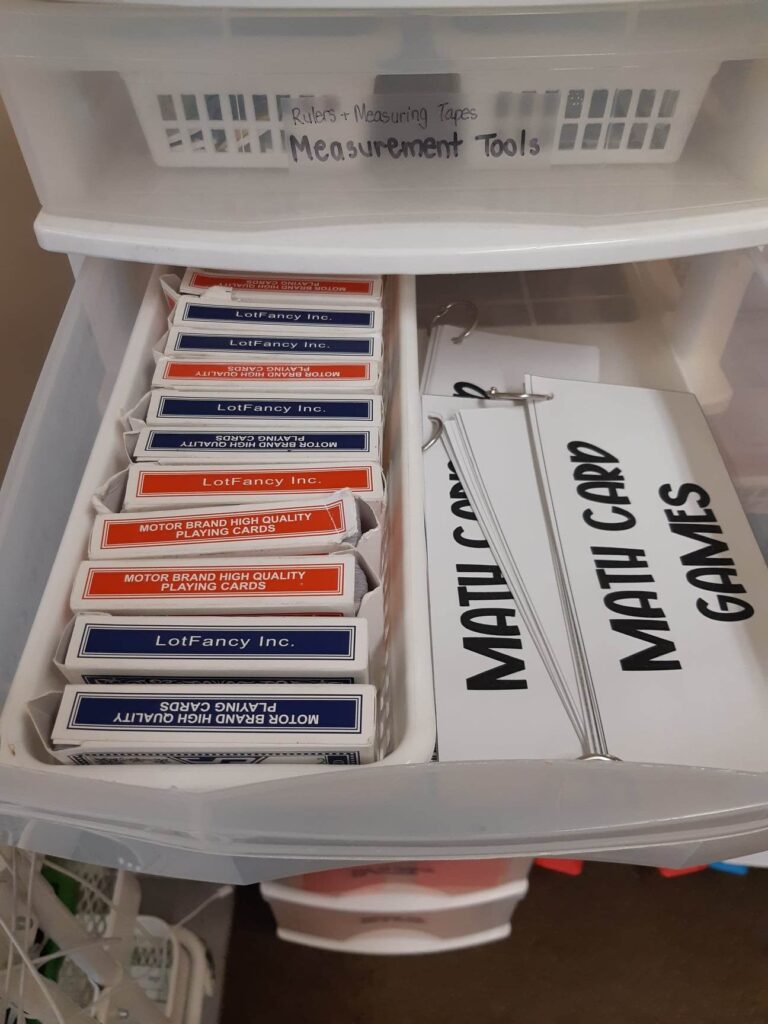
What are the benefits of using menus for math?
Teachers benefit from math menus because they:
· meet with all their students at least once a week
· can reduce their marking time
· print fewer worksheets
· give their students more opportunities to collaborate
· get buy-in from students; math menus are fun!
Students benefit from math menus because they:
· get small group time with a teacher every week
· do fewer worksheets
· have opportunities to choose activities
· get to choose between working and playing independently or with friends
· discover that math is fun!
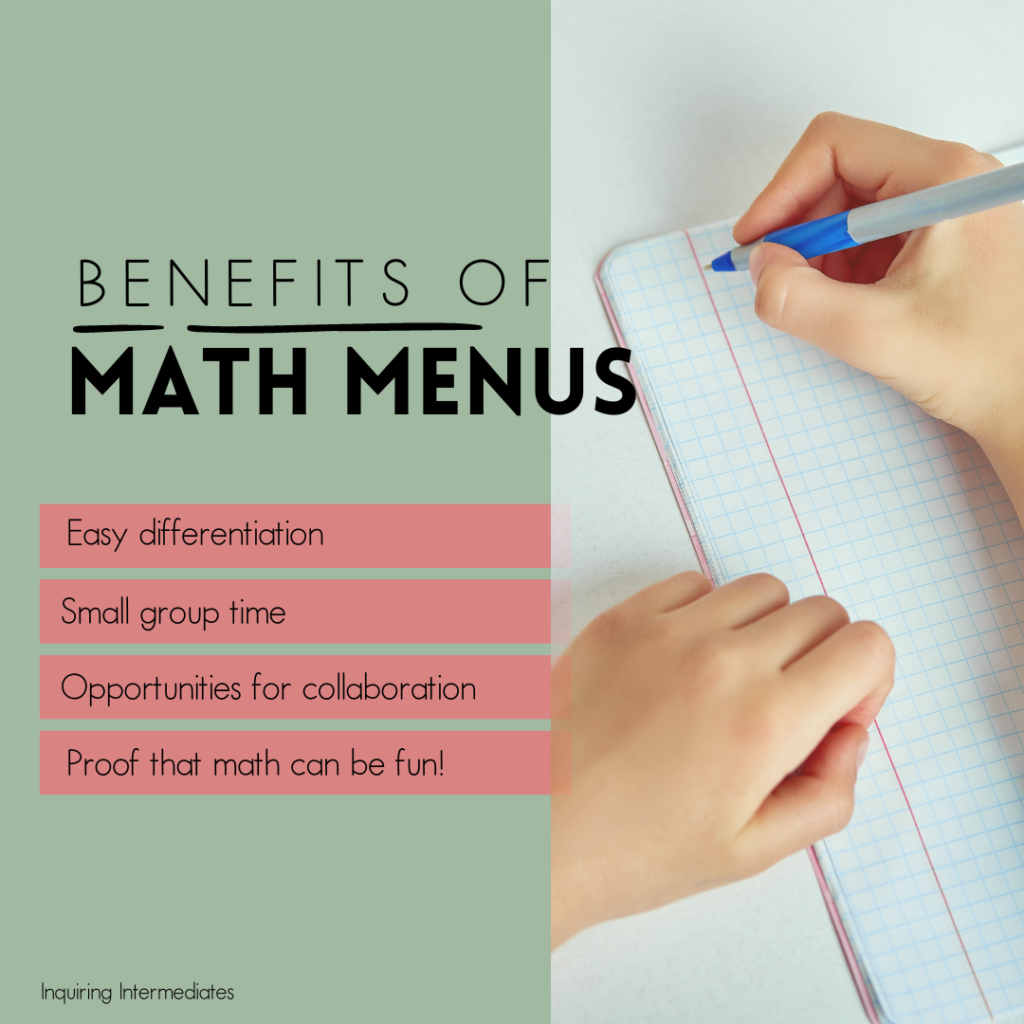
How much does it cost to set up math menus?
I was worried that setting up math menus would be expensive, and… it was. But it didn’t have to be! I did buy several things, but I know people who have started them without buying anything new at all. Here’s what I bought:
· Four Think Fun Games (three purchased with classroom funds, one that was gifted) – $80
o Free alternative: similar games that are available online.
· Unifix cubes and base ten blocks (from Facebook Marketplace) – $50
o Free alternative: See if your school has a set of these that you could keep in your classroom or if a colleague has a set you could borrow for a bit. If not, see if families are willing to donate LEGO or DUPLO to use in place of unifix cubes.
· Two pop-Its – $30
o Cheap Alternative: Sharpie on a dollar store pop-it will do the trick, although you will need to re-Sharpie periodically and may not find a cheap one with one-hundred bubbles.
· Math picture books (with Indigo gift cards from students at Christmas or last June) – seven for $80 + the cost of what I already had
o Free alternative: See if you can borrow books from your school or local library and/or print a QR code that goes directly to a curated collection of math books on Epic (free options available).
Total: $240… or whatever your budget is (which honestly could be nothing). Please don’t feel pressured to spend YOUR money on something that should be government funded! I’m not sharing this to make anyone feel bad, I’m just trying to be transparent.
If you’re looking for free math menu activities, I’d highly recommend checking out Juliana Matherson‘s website or signing up for her email list; she shares some great stuff!
So... are you itching to set up math menus? Save this post for future reference!
